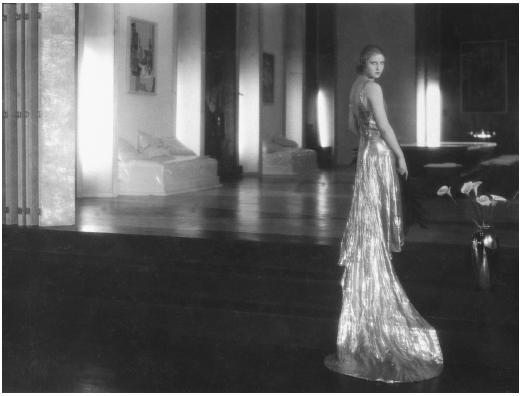L'ARGENT - Film (Movie) Plot and Review
France, 1929
Director: Marcel L'Herbier
Production: Cinemondial and Cineromans; black and white, 35mm, silent; length: 5344 meters, running time: 195 minutes. Released 10 January 1929. Filmed in Francouer studios at Joinville; exteriors shot at La Bourse, Place de l'Opera, the Paris Stock Exchange, and Le Bourget; cost: more than 3 million francs.
Producer: Simon Schiffrin; screenplay: Marcel L'Herbier, from the novel by Emile Zola; photography: Jules Kruger; production designers: Lazare Meerson and André Barsacq; art director: Jacques Manuel; costume designer: Jacques Manuel.
Cast:
Mary Glory (
Line Hamelin
); Brigitte Helm (
Baron Sandorf
); Yvette Guilbert (
Le Méchain
); Marcelle Pradot (
Countess Alice de Beauvilliers
); Esther Kiss, Elaine Tayar, and Josette Racon (
Switchboard operators
); Mona Goya, Yvonne Dumas, Maries Costes (
Extras
); Pierre Alcover (
Nicolas Saccard
); Alfred Abel (
Alphonse Gunderman, the banker
); Henry Victor (
Jacques Hamelin
); Pierre Juvenet (
Baron Defrance
); Antonin Artaud (
Mazaud
); Jules Berry (
Huret, the reporter
); Alexandre Mihalesco (
Salomon Massias
); Raymond Rouleau (
Jantrou
); Jean Godard (
Dejoie
); Armand Bour (
Daigremont
); Roger Karl (
Banker
); Jimmy Gaillard (
The groom
); plus Les Rocky Twins, Raymond Dubreuil, Garaudet, and Tardif.
Publications
Script:
L'Herbier, Marcel, L'Argent (includes list of scenes, some dialogue), in L'Avant-Scène du Cinéma (Paris), 1 June 1978.
Books:
Jaque-Catelain présente Marcel L'Herbier , Paris, 1950.
Sadoul, Georges, French Film , London, 1953.
Armes, Roy, French Cinema , New York, 1970.
Burch, Noël, Marcel L'Herbier , Paris, 1973.
Brossard, Jean-Pierre, editor, Marcel L'Herbier et son temps , La-Chaux-de-Fonds, Switzerland, 1980.
Canosa, Michele, Marcel L'Herbier , Parma, 1985.
Articles:
New York Times , 23 September 1968.
Blumer, R. H., "The Camera as Snowball: France 1918–1927," in Cinema Journal (Evanston, Illinois), Spring 1970.
Jouvet, P., in Cinématographe (Paris), May 1977.
" L'Argent Issue" of Avant-Scène du Cinéma (Paris), 1 June 1978.
Trosa, S., "Archéologie du cinéma," in Cinématographe (Paris), December 1978.
Petat, J., "La Gratuité ce L'Argent ," in Cinéma (Paris), March 1979.
Fieschi, J., "Marcel L'Herbier," in Cinématographe (Paris), December 1979.
Cousins, R. F., "Adapting Zola for the Silent Cinema: The Example of Marcel L'Herbier," in Literature/Film Quarterly (Salisbury, Maryland), January 1984.
Ciment, Michel, "Je ne cherche pas une description mais une vision des choses," in Positif (Paris), no. 430, December 1996.
Le Clezin, J-M. G., "A penz," in Filmvilag (Hungary), vol. 40, no. 10, 1997.
Marcel L'Herbier is a key figure of 1920s French cinema and his modernization of Emile Zola's novel, L'Argent , released in 1929 on the eve of the sound revolution, is his most ambitious work. The scope of the film is inspired by Abel Gance's Napoléon , but rather than talk

The 1920s was a period in which directors like Gance and L'Herbier seized the opportunities for individual expression offered by the disorganization of the French film industry. This was a cinema in which the key contributions of noted set designers were set against a continuing interest in location filming. As L'Argent shows, a preoccupation with visual effects—decor and movement, masking and superimpositions, slow motion photography, symbolic lighting and so on—did not imply any disregard for the real social world or for nature. L'Argent was not particularly highly esteemed by traditional film historians, but recent critical work, especially that of Noël Burch, has pointed to the great richness of the film even if the "modernity" claimed for it remains a problematic concept.
L'Herbier, like other 1920s filmmakers, refused to subordinate the visual style of his filmmaking to the demands of narrative continuity, which was already dominant in the United States and elsewhere. The type of cinema of which L'Argent is a key example can only be understood if the claims to primacy of narrative are disregarded and film is accepted as a mode of expression which may legitimately captivate its audience by other means. In this sense a work like L'Argent forces upon us a widening of the conception of cinema to take in forms fundamentally alien to the Hollywood tradition. The question of what value is to be attached to this alternative approach is, however, more complex. Noël Burch and others have prized L'Argent very highly as an example of a vitally important modernist cinema. But in a sense this distorts history, since the conventions L'Herbier was disregarding were not as fully established in France, and the Hollywood-style production practices which would have supported them were totally lacking. Moreover the weight of 19th-century traditions of art and literature weighs heavily on L'Herbier, and a true evaluation of L'Argent would need to take into account also the conventional content, subject matter and ideological assumptions, as well as the visual and rhythmical audacities. But Burch's claims do make a refreshing alternative to the customary denigration of 1920s French cinema and open fascinating perspectives for future research.
—Roy Armes
Comment about this article, ask questions, or add new information about this topic: